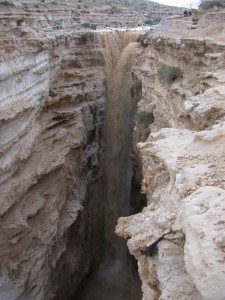Floods
Rivers in the Desert
Although rainfall is comparatively low in the Negev it can nevertheless cause torrential floods. This happens when rain falls at a high intensity and is subsequently intercepted by the rocky and crusty terrain. Gravity pulls the surface water from sloping terrain into wadi systems which eventuallyform rapidly flowing rivers which are so powerful that anything in their ways is washed away.
Ancient civilizations carved citerns into softs rocks that align the wadis and used them for water storage. When the rain ceases and rivers run dry, significant amounts of water have also
infiltrated the soil. The air is smelling increadibly fresh after each rain event and is loaded with aromas from emerging herbs and flowers. It is the time when organisms have to rush through their developing cycles before the blazing sun dries up the desert soils during long and rainless summers. Signs of hydrological phenomena can be observed all year round, particularly when visitors chose slow modes of travelling such as hiking or horseriding. Chances of experiencing rain events are extremely low, but it is advisable to chose an experienced guide during winter months for avoiding the danger of getting caught in a flash flood. Different tour options are available for exploring the unique ecohydrological features of the Negev.
